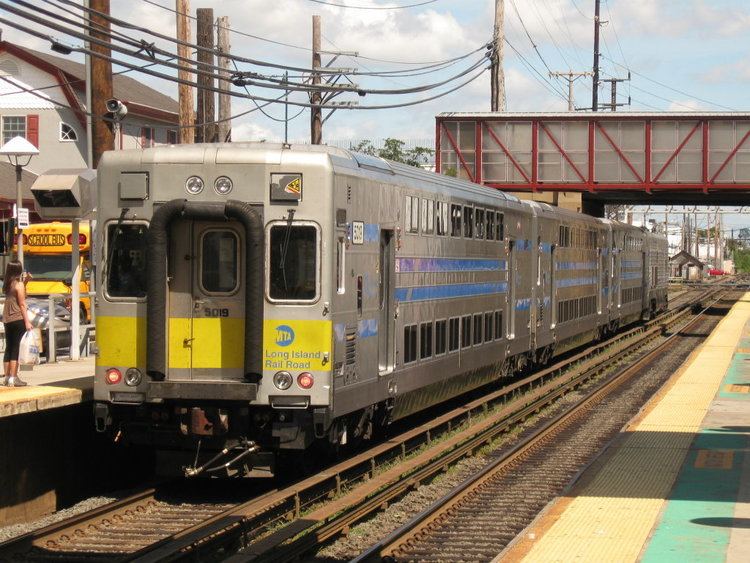Status Operational Stations 10 (2 others closed) | System Long Island Rail Road Termini JamaicaOyster Bay Daily ridership 6,000 | |
 | ||
Lirr oyster bay branch and main line 4 6 7 91
The Oyster Bay Branch is a rail line and service owned and operated by the Long Island Rail Road in the U.S. state of New York. The branch splits from the Main Line just east of Mineola station, and runs north and east to Oyster Bay.
Contents
- Lirr oyster bay branch and main line 4 6 7 91
- Lirr m7 mineola train 7726 heads up the oyster bay branch during ellison ave project 5 16 15
- Early history
- 20th century to present
- References
Lirr m7 mineola train 7726 heads up the oyster bay branch during ellison ave project 5 16 15
Early history
The first phase of what is now known as the Oyster Bay Branch opened in January 23, 1865 as a branch of the Long Island Rail Road to Glen Head known as the Glen Cove Branch Rail Road. Two years later the railway was extended to Glen Cove and on April 19, 1869 the line was extended further to Locust Valley.
By the early 1880s, there had been pressure to expand rail service eastward. At this time another railroad, the Northern Railroad of Long Island threatened the Long island Rail Road's monopoly. The Northern Railroad was incorporated on March 23, 1881, and it planned to build a road from Astoria to Northport via Flushing, Great Neck, Glen Cove, Oyster Bay and Huntington. By June 1881, construction plans were authorized and in mid-July the building contract was signed, with work set to begin in August. The Long Island Rail Road attempted to undermine the Northern Railroad's project before it could sell stock and acquire a roadbed. It was going to link its north side branches together as a continuous railroad to Northport. Construction cost from Great Neck to Roslyn and from Locust Valley to Northport was approximately $400,000.
In February 1883, Austin Corbin, president of the Long Island Rail Road, offered to supply iron and rolling stock for the extension to Oyster Bay if local residents provided the right-of-way. While citizens considered the offer, the Northern Railroad folded since not enough money was raised. With the threat eliminated, the extension of rail service to Oyster Bay was temporarily delayed. The project was revived in 1886 when some citizens offered to secure a right-of-way. In June 1886, a public meeting was held and a committee of fifteen was appointed to secure land. Although officials were still contemplating a through line to Northport, the LIRR organized the Oyster Bay Extension Railroad on August 31, 1886, which authorized a five-mile road from Locust Valley to Oyster Bay. Ground was broken for the project on August 15, 1887. One phase of construction was the building of a bridge over what is now Tunnel Street in Locust Valley. The masonry project began in October 1888 and the arch was finished on April 13, 1889. The entire bridge was completed by September.
On June 24, 1889, the extension opened with a huge celebration in Oyster Bay. A ceremonial train of ten cars left Long Island City about 9:30 a.m. and was met at Locust Valley by ten young ladies who decorated the locomotive with flags and wreaths. Upon arrival at Oyster Bay, an organized procession commenced, which was viewed by 5,000 residents and visitors. On Tuesday, June 25, the extension opened for regular passenger service with eight round trips daily to and from Long Island City.
The line ended at Locust Valley for two decades until a final extension added four miles to Oyster Bay. One of the reasons for building to Oyster Bay was to create a connection to New England. A large pier, now owned by the Flowers Oyster Company, was built to facilitate the loading of passenger cars onto a ferry, specifically to the Danbury and Norwalk Railroad station and ferry pier in Wilson's Point section of Norwalk, Connecticut. Service lasted only a few years as overland service from New York to Boston, once thought impossible, commenced.
20th century to present
Until 1928, a direct connection to the West Hempstead Branch existed just east of Mineola station. This spur crossed the Main Line, then terminated at the end of a wye at what was often called the Garden City Branch. Until passenger service was abandoned along this branch, passengers would transfer between the two lines at Mineola Station itself.
Except for the section between East Williston and Mineola, this branch is not electrified and thus can only be served by diesel powered-locomotive trains (except for one AM peak train that originates at East Williston and ends at Penn Station using Electric-Multiple Units). There were plans to electrify the entire branch in June 1934, but that never occurred.
In 2009, the LIRR replaced the bridge over West Shore Road between Locust Valley and Oyster Bay Stations.
